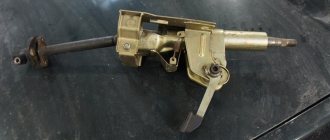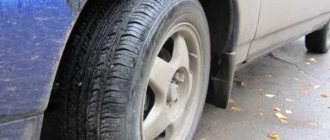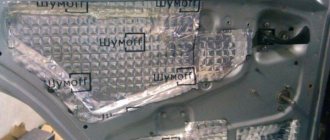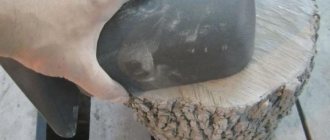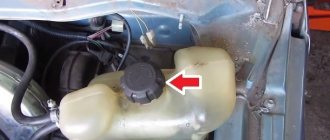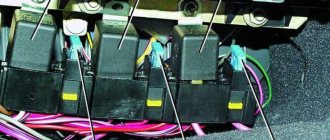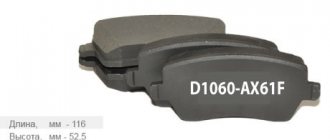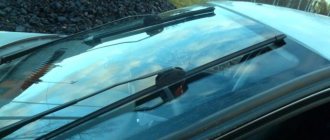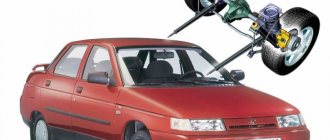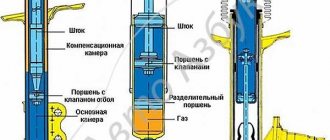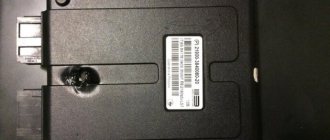Signs of steering rack defects, dozens and pre-repair preparation
A sign indicating problems in the steering mechanism, and most likely in the rack, is a knocking sound in the steering mechanism. It manifests itself when driving on a bumpy road surface, where the road is replete with potholes, holes and bumps from uneven soil or expanding asphalt. This creates a feeling in the car user that this knock is heard directly into the steering column. If such sounds occur in the steering system, it is necessary to diagnose it.
At this stage of identifying a defect, it is too early to conclude that the VAZ steering rack, the price of which is quite high for the average car enthusiast, requires repair or replacement. To clarify the “diagnosis” of the car, it is necessary to conduct a personal visual inspection of the area where the steering shaft is connected to the rack. To do this, you need to try to move the steering gear shaft with vertical jerks using your hand at the mounting point of the steering system components.
If knocking noises appear when moving up and down, then the car needs to be serviced. As a rule, such a knock is produced by a needle bearing that did not receive its portion of lubricant in time. An alternative to the knocking noise can be a weak fastener of the steering wheel bushing with the gear. In this case, it is necessary to tighten the fastening of the parts.
When the cause of the malfunction is established, the car owner decides on the need to replace or repair this important element of the steering mechanism. On our website there is a video on servicing the steering rack of a VAZ 2110, which demonstrates the procedure for repairing and replacing a part by a car chassis specialist
Replacing steering shaft bearings VAZ 2110 1996
1. Disconnect the wire from the “–” terminal of the battery.
2. Remove the steering wheel (see subsection 5.3.1).
3. Loosen the bolt securing the base of the steering column switches and slide the base towards you.
4. Disconnect the wire from the oil pressure sensor.
5. Disconnect the two connectors with the horn wires from the contacts on the base and remove the base of the steering column switches.
6. Insert the key into the ignition switch and turn it to position I to unlock the steering shaft.
7. Disconnect the ignition switch wire block from the wiring harness. If the ignition switch wires are connected to the wiring harness with a clamp, cut or loosen the clamp.
8. The steering column is secured with bolts with break-away heads (the same as the ignition switch). If new bolts with breakaway heads are not available, you can replace them with regular M6 bolts 20 mm long.
9. Unscrew two nuts and two bolts with break-away heads, remove spring and special washers. If the bolt heads are stripped, the bolts must be drilled out or removed using a screwdriver and hammer.
10. Remove the steering column from the studs, slide it towards you and lower it down. Then remove the bolt securing the propeller shaft to the steering shaft.
11. Remove the bolt and remove the column assembly, while removing the thrust bushing from the shaft. 12. Press the steering shaft along with the bearing out of the pipe. It is recommended to press the shaft towards the steering wheel mounting.
13. Remove the front (steering wheel side) bearing from the shaft.
14. Replace the steering shaft if the splines or threads are worn or damaged.
15. Using light hammer blows and a drift, press the rear bearing out of the steering bracket pipe.
16. Before installing the bearings, check that they rotate easily and without jamming. The plastic bearing bushings must not be damaged.
17. Press the rear bearing all the way into the pipe collar using a suitable mandrel, applying force only to the outer race of the bearing. The bearing is mounted on a plastic bushing, which has a wide flange on one side. When installing the bearing, it is the wide flange of the bushing that must be directed outward.
18. Slide the front bearing onto the shaft with the wide flange of the bearing bushing facing the end of the shaft.
19. Insert the shaft into the pipe. In this case, the rear end of the shaft should enter the rear bearing.
20. Press the front bearing all the way into the pipe collar using a suitable mandrel, applying force only to the outer race of the bearing.
21. Install the steering column in the reverse order of removal. Install the thrust bushing on the shaft with the side with the larger diameter.
22. Install special washers for the bracket fastening bolts with their protruding part a in the opposite direction from the bolt head.
23. When installing the base of the steering column switches, before tightening the bolt securing it, adjust the position of the base on the steering column. To do this, install the lower casing and move the base so that the screw holes in the casing and the base match. After this, carefully remove the casing and tighten the base bolt. Install the steering wheel in the reverse order of removal.
Replacing the steering wheel
VAZ 2110 steering column cover
To replace the steering column you need the following tools:
- long powerful knob;
- 17mm and 30mm heads;
- mount;
- ratchet handle;
- regular open-end wrench 17 mm.
Removing the steering wheel
The initial step in the process of replacing the column on a VAZ 2110 should be removing the old part. First you need to remove the steering wheel. In order to remove the steering wheel, you will need the following tools:
- 24 mm socket wrench;
- flat screwdriver;
- 5mm hex wrench.
Work to remove the wheel is carried out in the following sequence:
- The negative terminal of the battery is disconnected.
Note. This is necessary to prevent short circuits and wire connections.
- then you need to turn the steering wheel so that the wheels are level;
- Next, you need to unscrew the screws securing the column casings (there should be seven of them) and remove the lower protection located under the steering wheel;
- then you need to unlock the steering column lever and lower the column down;
- moving upwards, remove the upper steering casing;
- use a screwdriver to pry up the decorative trim, unscrew the two screws and remove the horn button;
- Unscrew the steering wheel mount.
Note. The steering wheel lock is not unscrewed completely, but in such a way that it can move freely along the shaft.
VAZ 2110 steering column
Note: The steering wheel is quite rigidly fixed to the shaft splines. This must be taken into account, and when removing it, make sure that the steering wheel hub has come off the shaft grooves and only then unscrew the wheel securing nut. If this sequence is not followed, the wheel may suddenly come off, thereby causing injury to a person or damage to the vehicle.
Before you finally remove the part, you need to remember or record with a marker its location relative to the shaft. Similarly, the position of the turn signal switch should be fixed in relation to the plastic ring. Next, sharply pulling the ring towards you with your hands, remove it from the grooves of the shaft. Unscrew the fastening nut (now completely) and finally remove the steering wheel.
Note. After completing work on replacing the column, the steering wheel should be put back in place. The sequence of work should be the reverse of the above steps.
Dismantling the column
VAZ 2110 knocking in the steering column
After the steering wheel is removed, you can continue replacing the steering column. It is necessary to remove the steering column joysticks from the steering column, remove the ignition key and remove the ring trim of the anti-theft system transponder. Then, inserting the ignition key and turning it to the desired position, do the following:
- Use a thin screwdriver to tighten the locking pin through the ignition switch hole;
- remove the lock cylinder from the housing.
Next you need to do the following:
- remove the attached IMMB (transponder) block from the column;
- Disconnect the electrical wiring and transponder unit from the housing.
Note: On units equipped with latches, you will need to remove the ignition lock cylinder and then separate the transponder assembly from the lock body. If such a need arises, you can remove the protective cap and disconnect the wiring.
Removed VAZ steering wheel
After this, you need to carefully remove the speakers, covers and springs. Then remove the electrical wiring cord from the steering column, and then remove the air supply hose to the driver’s foot well and the lower sections of the instrument panel trim. Now you need to mark the position of the upper connection of the intermediate shaft in relation to the steering column, then unscrew and remove the clamp bolt. Next you need to remove the shaft from the splines.
Note: models equipped with a stabilization system require disconnecting the electrical wiring from the sensor that regulates the steering wheel rotation. Using a screwdriver, you need to move the latch and remove the sensor from the nozzle and slightly move it down.
Steering column cover VAZ 2110
To continue, you need to support the steering column and loosen the upper mounting bolts and the lower column clamp. If necessary, you can release the lower fastening without bending the grip. On models equipped with a stabilization system, pull the column up and unfasten the sensor that is installed in its lower part. Next, you should remove the column from the support bracket and remove it from the interior of the VAZ 2110 car.
Note: it is important to remember or record the locations of all kinds of washers and gaskets that are installed between the lower clamp and the upper steering column mounting bracket.
What is needed to replace the steering rack of a VAZ 2110
To replace the old rack with a new VAZ 2110 we will need: WD-40 fluid, a vice, a puller for removing the tips or a hammer, an open-end wrench “13”, “22”, “19”, a socket wrench with a head “13” , “17”, “22”, chisel and screwdriver, pry bar, jack, new steering rack.
You should pay attention to the fact that the VAZ 2110 power steering steering rack with the article number (21100340001030) costs much more. When buying a new rack, it is more profitable to take the rack assembled so that there are rod ends, etc., and it is better to choose a new part when you have the old one on hand
The price of a standard rack for a VAZ 2110 with article number (21100340001200) will be about 2,500 rubles, and an improved version with power steering costs 15,000 rubles.
The cost of spare parts is indicated for spring 2021 in Moscow and the region.
Removing the steering column
If after adjustment the problem with the rack does not disappear, you will have to disassemble and repair it. But to do this it needs to be removed. There are two methods of dismantling: with and without tie rods. The latter method is preferable as it requires much less time. Before removing the steering rack on a VAZ-2110, the front part of the car needs to be jacked up on both sides. This is necessary in order to unload the traction.
In the cabin, in the area of the pedal block, you need to unscrew the steering shaft cardan bolt. After this, we go to the engine compartment and unscrew the 2 bolts securing the rods, having previously bent the locking plate. Then you need to unscrew the 4 bolts securing the steering column to the car body. When this is done, remove the column and remove it through the opening of the left wheel arch.
We carry out repairs
Remember that this unit is a rather “delicate” and fragile mechanism.
under the octagonal nut of the stop there is a spring that needs to be removed;
then remove the retaining ring, which is located under the specified spring;
lightly tap the wooden spacer to tap the rack stop out of the crankcase (note that there is a rubber sealing ring in the groove of the stop);
Next you need to remove the front shield seal;
- under the seal there is a boot, which is also removed (you can use a screwdriver that has a wide and thin blade);
- behind the boot there is a locking ring, which is also removed;
Using a 24mm octagonal head, unscrew the gear bearing mounting nut and remove the nut from the shaft;
we press out the shaft from the gear together with the bearing using a 14mm wrench, which we rest on the mounting blade; the shaft can be clamped in cleats;
Cotton steering wheel and how to deal with it
The design of front-wheel drive VAZ cars corresponds both to its price niche and partly to its purpose. An average car for economical travel over average distances at average speed. Know-how of the 80s of the Soviet automobile industry, the MacPherson suspension coupled with rack and pinion looked like something perfect in the early 80s. Although, in fact, the long-travel steering rack 2108 and the classic MacPherson of the 1948 model are not the most progressive solution even for a cheap car.
Compared to classic VAZ models, rear-wheel drive, with a classic steering mechanism and double-wishbone front suspension, the 2110 has more sluggish and imprecise handling. In a word, a wadded steering wheel. It won’t take long to figure out why this happened. Elementary geometry - MacPherson does not hold the car well in turns and during acceleration and braking, and the steering had a long stroke and an unsuccessful upper rack location. Hence the looseness of the steering wheel. It is technically inherent and cannot be cured by any settings or adjustments.
Video tutorial on repairing a VAZ steering rack
However, since the 2000s, a slightly improved design of the power steering rack has been used. There wasn’t enough for everyone at once, because first of all, cars with hydraulic booster were exported. Later, when Europe was full of Zhiguli cars, cars with power steering began to appear more often. But the hydraulic booster did not save the situation. And that's why.
Step-by-step replacement of the steering column
Having decided to replace the steering column on a VAZ-2106 yourself, you need to stock up on free time and patience, and experts recommend performing this step in stages:
- The steering shaft, which is clamped in the column, should be carefully removed.
- Using a size 30 wrench and a long wrench, you should try to rip off the connecting nut that secures the steering column. It is not always possible to remove the fasteners the first time, but since this stage is mandatory, you have to return to it several times.
- The three fasteners that connect the column to the car body are unscrewed. It is most convenient to use a so-called ratchet for this process, since the bolts are not so easy to get to with a regular wrench.
- After unscrewing all the fasteners, you need to free the column from the tie rod splines, which continue to hold the assembly. To do this, you should pry the structure with a pry bar and try to knock it down with sharp jerks.
- After dismantling the unit, it is necessary to check the condition of the boot and oil seal; if even minor damage is detected during a visual inspection, these components must be replaced. By installing a new boot, the life of the bearing and shaft will be extended, and the new oil seal will not allow automotive lubricant to leak out of the steering column.
If all components are installed correctly, the car owner will replace the failed elements with high-quality and reliable ones, and the steering column will have a long service life.
To simplify the assembly process, experts recommend putting all the removed elements from the car in strict sequence, so that when assembling the structure, you don’t confuse anything and repeat the whole process again.
As you can easily see, the process of replacing the steering column of a VAZ-2106 is not that complicated, so every car owner can do it if he has the strength and patience and, of course, does all the work step by step. But if difficulties still arise when replacing a car element, it’s time to use the hint, which at a convenient time can be found in the video instructions on the Internet resource. The educational video lesson is conducted by qualified specialists who understand the intricacies of car repair and present their visitors with extremely effective and most necessary advice on the topic of interest to them.
Removing the column from the car
Note: The steering wheel should not be tightened with a jerk, but with a slight rocking, either to the left or to the right, and at the same time pull the part towards you. We did not unscrew the nut completely, because the steering wheel can jump out of engagement with the shaft abruptly, then it is easy to get a facial injury. After the steering wheel has come off the splines, you can unscrew the nut completely
To replace the driveshaft, you need to disassemble and remove the steering column from the VAZ 2112, let's proceed to removal:
- First of all, de-energize the battery by removing the terminals
- Then remove the signal cover trim from the steering wheel (by prying it off with a screwdriver)
- Now we will have to unscrew two self-tapping screws, you can figure this out using a Phillips screwdriver
- After this, remove the lid completely.
- Then, using the same Phillips screwdriver, we unscrew the screws (three in total) that secure the signal contact
- Remove the contact by disconnecting the wiring
- Now you will need the “24” key to operate.
- Use it to unscrew the nut that secures the steering wheel (Unscrewing is not done completely, leave the nut slightly screwed onto the shaft)
- We tighten the steering wheel by pulling it towards ourselves
Tip: If the steering wheel is firmly seated and you can’t remove it alone, then ask a friend or acquaintance for help, let him pull the steering wheel up, while you hit the shaft with a hammer through a soft metal or wood attachment.
- Then the steering column cover of the VAZ 2112 is removed
- Next, the block under the steering switches is dismantled
- The ignition switch is removed
- Then, using the “13” key, unscrew the bolt that secures the elastic coupling (it is located under the pedals)
- We unscrew the bolts that secure the steering shaft in front
Note: The lock fastenings are fixed with special bolts (their heads are cut off), this eliminates any possibility of ordinary unscrewing. Using a chisel and hammer, strike to get them out of place, then you can use pliers to unscrew them.
- Taking the key “13”, unscrew the nuts that secure the steering control to the rear
- Pulling out the column
- This completes the removal instructions.
Checking the oil level in the steering column on a VAZ 2101-VAZ 2107
Welcome! Steering column - thanks to it, both front wheels of a rear-wheel drive car of the “Classic” family are turned. In order for the steering wheel to rotate well and with little effort, the steering column is constantly lubricated with oil located inside it. But like any other oil, the oil inside the steering column disappears over time, and therefore its level must be constantly monitored and topped up whenever possible. You can find out how to check the oil level below.
Note! To check the oil level in the steering column, you will need to take: “8” wrenches, and also, just in case, take with you a funnel, clean oil and a brush or just a rag!
Where is the steering column located? Most likely, you have already seen where the steering column is installed, and more than once, because it is located in almost the most visible place, namely in the engine compartment of the car, on the left side (Indicated by a red arrow), and just above the steering column is the main brake cylinder on the photo indicated by the blue arrow.
Steering column for VAZ 2110 do-it-yourself repair
steering adjustment
We carry out the work on an inspection ditch or a lift.
Using pliers, remove the cotter pin... ...and use a 22mm wrench to unscrew the nut securing the middle link to the pendulum arm. Using a fork puller, we press the middle thrust ball pin out of the hole in the pendulum arm of the Niva 2131. The pin can also be pressed out by applying a sharp blow from below (near the hinge) with a chisel with a blunt end to the pendulum arm. Remove the ball pin from the eye of the pendulum arm.
Similarly, we press the ball pin of the VAZ 2131 rod out of the bipod.
Remove the middle link.
Install the middle link in the reverse order.
The left hinge pin (inserted into the bipod hole), in addition to rotation, can swing (unlike the right one).
At the same time, when installing the VAZ 2121 on a car, we orient it so...
...so that its longitudinal axis is in front of the Niva 2131 hinge axes.
Checking and adjusting the steering of VAZ 2121, Niva 2131
- – Steering gear adjustment
- – Replacement of side rod
- – Removing and installing the middle link
- – Replacement of steering tips
- – Assembling and disassembling the lever bracket
- – Removing and installing the steering wheel
- - Steering column
- – Replacement of the steering mechanism
- – Steering bipod
Steering design of VAZ 2121, VAZ 2131
Features of the Niva 2121 steering device. Adjusting the steering column, eliminating knocks in the Niva 2131 steering mechanism.
DIY steering repair design- Check and adjustment
Steering adjustment, inspection and maintenance
NIVA / 2121, 2131 / repair / steering / checking and adjustment / Removing and installing the middle link
Replacement and repair of main parts
When a malfunction is detected, you need to collect all the necessary parts and tools for the VAZ 2110. You will definitely need sets of screwdrivers and wrenches. It is also necessary to check the availability of socket heads, pliers, a metal brush and a special puller that is used to service the device. If it is not there, then a small crowbar or hammer will do as an alternative.
How to change tips and rods
Replacing tips and rods is as follows:
- The first step is to jack up the VAZ 2110 and remove the front wheel;
- The area where the rack tip attaches to the steering knuckle must be thoroughly cleaned, and then the nut must be treated with WD-40;
- Next, you need to remove the cotter pin securing the connection; for this you will need pliers;
Remove the wire fixing nut by pulling one end with pliers - After this, you need to remove the finger using a special puller, after unscrewing the nut;
- Once the pin is removed, the tips can be unscrewed and removed. They must be checked for defects and replaced if necessary;
Removing the finger - Having removed the tips, you should bend the plate at the bolt to get to the rod;
- The next step is to unscrew the rod bolt;
- Done, now the rod and its ends can be dismantled. Replacement is carried out in reverse order. After installing new parts, you need to check the steering wheel without completely assembling the entire steering mechanism. If everything works, the steering wheel does not move tightly and does not wobble, then assembly can be carried out.
Diagnosis of steering problems dozens
Every car has weaknesses. For VAZ 2110, this is the tie rod end. This part is an integral part of the car's steering system. The tie rods on the tenth generation VAZ end with tie rod ends. Rods are rarely changed, but tie rod ends must be replaced every 40 thousand kilometers of the car.
But this is an average and approximate figure. The service life of the steering tip depends on the driving style of the car owner and the conditions in which the car is operated.
Any driver of a vehicle can notice a problem with the steering. The main signs of the need to replace steering tips on a VAZ 2010 are as follows:
- difficulty driving, especially when turning;
- strong noise and knocking from one or both sides in the front, more pronounced when turning;
- The tread on the tires wears unevenly.
In the latter case, most likely the problem is not only with the tips. It is necessary to diagnose the front suspension as a whole. Perhaps replacing the tie rod end won't do the trick.
The steering tips in the VAZ 2110 car are a hinged joint. Wear in the tip joint leads to a malfunction in the steering. You can check the steering tips on the VAZ 2110 yourself.
First of all visually. To inspect the tip on the left side of the car, you need to turn the steering wheel all the way to the right; to inspect the right steering tip, turn the steering wheel to the left.
You should pay attention to the rubber boot that protects the tie rod end. If it is torn or cracked, then it is time to replace the tips.
Through the hole in the boot, dust and dirt enter the hinge, which leads to faster wear of the steering tip.
To carry out the second stage of diagnosis, it is necessary to jack up one of the sides of the car so that the wheel is freely suspended in the air. Tug the tip with your hand, if there is any play, then you need to replace the steering tip. The tips should be changed on both sides. It is not worth saving and changing one tip; it is better to save on the services of a service station technician and carry out the replacement procedure yourself.
Selection of repair kit
Before starting repair and restoration work, you should decide on the choice of repair kit.
Minimum set. This set includes the necessary list of fastening and sealing elements: washers, bearings, nuts and fluoroplastic bushings.
The basic set has bearings and shafts in addition to the minimum set, but its cost can be twice as high as the first option.
Please note that the steering rack can be either old or new. The old racks are designed for the VAZ 2108, while the new ones are designed for the “tenth” model. The new version is also more convenient to repair. If there is a need to repair the steering rack, which involves replacing the bushing, then there is no need to disassemble the entire mechanism. Remove the corrugation, unscrew the central nut and disassemble the rack into two component parts. One part will contain the mechanism, and the other part will be the one where the bushing is located.
Preparatory activities
The first thing you need to do is buy a steering rack repair kit. Without it, starting work is completely useless. The set may have different configurations.
- Minimum (washers, fasteners, bushings, nuts, bearings).
- Medium (in addition to all of the above, shafts are added). The cost of such a kit is twice as much.
- Maximum (everything is included here, including the rack).
Please note that there are different slats - old and new. The former are intended mostly for the VAZ 2108, and the latter for the VAZ 2110. It is better, of course, to give preference to the second option, because in this case the bushing is much easier to change (there is no need to disassemble the entire rack).
Main symptoms of a malfunction
Everyone has long known that any mechanism sooner or later becomes completely unusable and breaks down. Most often, the parts of the steering column in the VAZ 2112 wear out. Especially after driving off-road or on bad roads, which is still relevant in Russia today. If the cardan shaft or other steering component malfunctions, a knocking sound is heard, which indicates the need for repairs. Below are the main symptoms that characterize a malfunction of the driveshaft, and the steering wheel in general:
- Take the steering shaft with your hands and move it up and down, in the area where it connects to the rack, you can hear a characteristic knock
Note: Be aware that this knock does not always indicate the need to replace the driveshaft; there is a possibility that the needle bearing has collapsed and was left without lubrication.
- The knock appears when there is noticeable play in the bushing at the junction of the rack and pinion
Often the cause of knocking or play is poor tension of the fastening units, which requires you to do this:
- Take a wrench or pipe wrench, as necessary
- And tighten all loose nuts and bolts thoroughly.
If this does not eliminate the cause, it means either the driveshaft is broken, or it’s time to buy a new steering rack to replace it
Steering innovations
It seems like the issue has been resolved. Now it was possible to increase the force on the steering wheel, make the number of revolutions from lock to lock minimal, everything was smoothed out by the amplifier, but another problem arose. The car is operated in too different modes and the exact dosage of the steering angle at speeds of 140 and 55 km/h have completely different values. Not to mention the fact that there was almost no effort on the steering wheel, which made the steering even more insane. Then we had to change the design of the steering rack again. This time the objects of attention were the rack/pinion pair. Installing a new pair helped. The new steering rack was called “short” because the number of steering revolutions was reduced from 3.8 to 2.9. As a result, the waviness has almost disappeared and the steering wheel has become sharper.
Diagnosing the malfunction
Like any other mechanism, the steering rack fails sooner or later.
A similar mechanism is present in any car, both equipped with electric and hydraulic booster and without it.
Muffled sounds and impacts can be felt when driving over uneven surfaces, and can also be transmitted to the steering wheel.
The malfunction manifests itself in a similar way when the car is stationary and the steering wheel is turned.
When turning the steering wheel, a significantly increased force may still be observed.
These main symptoms indicate that the steering rack needs to be repaired, no matter what brand of car they appeared on: VAZ 2110 or another model.
To determine the state of this node, we do the following.
How does the steering mechanism work?
Steering
injury-proof, with a height-adjustable (tilt-angle) steering column, and a rack-and-pinion steering mechanism.
Steering gear
assembled with steering rods, it is attached in the engine compartment to the front panel of the body on two brackets using brackets 2 (Fig. 1). The mechanism is secured with nuts on welded bolts through rubber pads (supports) 3.
A drive gear is installed in the steering gear housing 5, which meshes with the rack.
The steering shaft consists of an upper 14 and an intermediate 10 shaft, connected to each other by a cardan joint. The intermediate shaft is connected to the drive gear by a flange through an elastic coupling. The upper shaft is installed in the bracket pipe 21 on two ball bearings with elastic bushings on the inner ring.
Fig1. Steering parts: 1 – inner tie rod ends; 2 – steering gear mounting bracket; 3 – steering gear support; 4 – spacer ring; 5 – steering mechanism; 6 – sealing gasket; 7 – thrust plate of the seal; 8 – seal; 9 – lower flange of the elastic coupling; 10 – intermediate steering shaft; 11 – coupling bolt; 12 – spacer sleeve; 13 – facing casing (upper part); 14 – upper steering shaft; 15 – steering wheel; 16 – signal switch cover; 17 – adjusting sleeve; 18 – steering column position adjustment lever; 19 – retaining ring; 20 – facing casing (lower part); 21 – steering shaft mounting bracket; 22 – steering shaft bearing; 23 – adjusting rod; 24 – outer tie rod end; 25 – spring ring; 26 – protective cap; 27 – sealing ring
At each vehicle maintenance check the condition of the protective cover, the protective caps of the 26 linkage joints and the tightness of their fit. They must be replaced if there are cracks, ruptures or other defects that impair their tightness.
Make sure that the steering wheel spoke is horizontal when the vehicle's wheels are straight. Otherwise, determine the cause of the problem and correct it.
Turn the steering wheel from lock to lock and check visually and audibly:
- reliability of fastening of the steering mechanism and steering wheel;
- is there any play in the rubber-metal joints, in the steering rod joints, as well as in the rivet and spline joints of the elastic coupling of the steering shaft;
-reliability of tightening and locking the bolts securing the rods to the rack and the nuts of the ball joint pins;
- are there any jams or obstacles that prevent the steering wheel from turning?
If knocking or binding is detected, disconnect the tie rods from the swing arms of the telescopic suspension struts and recheck. After confirming that the knocking and sticking noise is coming from the steering, remove the steering gear from the vehicle for repair.
The maximum permissible gap between the stop and the nut is 0.2 mm. If necessary, replace worn parts and adjust the gap between the stop and the nut.
How to adjust the steering rack on a VAZ 2110-VAZ 2112?
1. First, position the steering wheel so that both front wheels point straight forward, then remove the crankcase protection from below (If work is done from below and if the protection is in the way) and special. Using a wrench, rotate the steering rack adjustment nut counterclockwise by 10-15 degrees and immediately check the play at the rack, if necessary, perform the procedure again and do the same by 10-15 degrees, just be careful and always take into account that the steering wheel should not be very hard to spin.
Note! When adjusting, the most important thing is not to overdo it, tighten the adjustment nut a little at a time, about 10-15 degrees, and then check how the rack is adjusted, under no circumstances do a full turn of the adjustment nut, because you will only cause problems for yourself, because the steering wheel will not really turn, and unscrewing the nut is much more difficult than tightening it, so take this into account!
2. During adjustment, problems may arise, namely the inability to move the adjusting nut, it happens that you really can’t move it with your hands or with a hammer, but still, if you can’t do it with your hands, don’t forget about the hammer, if necessary you need to use it, namely insert special. key into the adjusting nut and hitting the tip of the key with a hammer, try to move the nut out of place.
Note! On new racks, as we said earlier, a plug is placed in this nut from the factory, it is picked up using a knife or a flat thin screwdriver, you don’t have to put this plug back, throw it away so that other people understand that the rack is far from new and has been adjusted , especially since you won’t even be able to put this plug back!
Additionally We recommend that you do this) You will gain new knowledge and learn about what was not indicated in the article.
Immediately arm yourself with a steering rack wrench specialized for the “ten”, and also get ready to remove the rods. From the tools, grab:
- Pliers;
- Mounting blade;
- Socket wrench 19;
- Hammer;
- Flat screwdriver;
- Set of heads - from 10 to 27.
Get started:
- Unscrew the nuts inside the passenger compartment and remove the fastening bolts of the lower universal joint to the steering rack gear shaft. To do this, you will need a 13mm socket. The bolt can turn, so hold it with an open-end wrench.
- In the engine compartment itself, remove the nut of the upper fastening of the rack boot.
- At the bottom of the car, remove two more nuts that secure the rack boot.
- Remove the boot.
- Raise the front of the car and remove the front wheels.
If you are going to remove the steering, but not dismantle the rods, follow these instructions:
- Remove the locking plate from the rod mount by prying it off with a screwdriver. Then unscrew the two bolts that secure the rods and rack;
- Using a 13mm socket, remove the nuts from the steering gear brackets connecting to the front panel;
- Move the rack forward a little to remove the gear shaft from the shield hole;
- Remove the rack together with the rods.
If you want to remove the steering rods, unscrew the rod end from the swing arm of the shock absorber struts. To do this you will have to do the following:
- Remove the cotter pin using pliers;
- Using a 19mm spanner, unscrew the ball pin fastening nut, but not all the way;
- Use a 17 socket to loosen the tension bolt of the rod end;
- Now press out the ball pin. To do this, insert a mounting blade between the swing arm and the tip. Press the tip away from the lever, and apply several blows with a hammer to the end of the rotary lever;
- Unscrew the ball stud nut completely;
- Remove the ball pin from the lever hole;
- Use a screwdriver to open the groove of the tie rod end;
- Remove the tip, holding the threaded adjusting sleeve with a 27mm wrench. Count the number of turns so that during reassembly you can tighten it by the same number of turns;
- On the tie rod, try to maintain the position of the threaded bushing. This way the toe angle of the wheels will remain as correct as possible.
